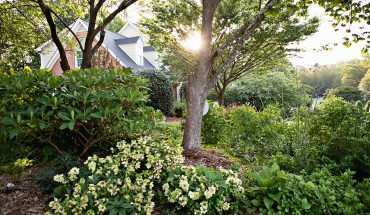by Liza Roberts
What nature can create, the gardener can nurture, tame, and frame. And, if you’re Greenscape floriculturist Leslie Herndon, turn on its head and hang on a wall.
Live, vertical, growing artwork is what Herndon creates year-round at Raleigh’s Cameron Village. With feather grasses and annuals, evergreen herbs, ferns, cherry tomatoes, and ivy, among many other plants, Herndon creates giant vegetal “paintings” to brighten otherwise-blank walls and spaces. These works incorporate a multitude of hues and textures, scents and shapes. She has made them to commemorate events, to celebrate seasons, and to encourage people to stop and smell, touch – even taste.
First patented in 1938 by University of Illinois landscape architecture professor Stanley Hart White and made famous more recently by French botanist Patrick Blanc, living walls – or vertical gardens, as they’re also known – represent a horticultural trend that has found its way to Raleigh and seems here to stay. The new Citrix building downtown, for instance, is home to a massive, two-story living wall that hangs from a crane left over from the building’s previous life as an industrial warehouse. Designed by the Baltimore firm Furbish and Alliance Architecture of Durham, the Citrix wall is home to 8,000 plants from 14 different species, including philodendron, orchid, and fern.
Not to be confused with wall-covering climbing vines like ivy or jasmine, walls like these incorporate live plants in individual containers, happily growing vertically and in precise formation. The growing-vertically part turns out not to be that big of a deal for the plants, Herndon says. It’s the tiny space for their roots that’s the challenge. It’s one of the reasons that living walls are hard to care for and haven’t yet gone mainstream outside of corporate settings.
Constant watering helps. Typically, watering systems are built into the scaffold or frame that holds the living walls up. The infrastructure at Cameron Village doesn’t allow for that, so Herndon’s creations are watered by hand six days a week.
They’re worth the effort, which begins with painstaking planning and experimentation. Herndon begins with a life-size sketch. She maps out color, shape, and texture, and decides what plants will help her achieve the desired effect. Then she plants the creations and waters and fertilizes them in careful conditions for up to eight weeks before installation.
Her inspiration comes from lots of places. She created an edible wall this past summer to help promote healthy living. Cherry tomatoes, basil, thyme, oregano, arugula, radishes, and carrots were all featured. It worked. “People actually ate things off the wall,” she says. “We had to rotate the plants out to replace them.”
Another time, she created a planted replica of Claude Monet’s famous painting San Giorgio Maggiore at Dusk (above). “I wanted to do something different,” she says. “I’m a big Monet fan.”






